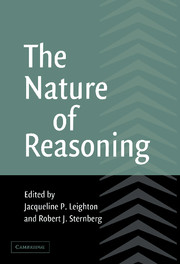Book contents
3 - Working Memory and Reasoning
Published online by Cambridge University Press: 05 July 2011
Summary
Memory and reasoning serve complementary functions. Memory serves to maintain access to previously acquired information (including information recently generated in the course of a task) while reasoning seeks to derive new information from old. The present chapter will be focusing particularly on the interrelations between working memory and reasoning. The role of working memory in reasoning was a key concern of the first papers setting out the highly influential Baddeley-Hitch working memory model (Baddeley & Hitch, 1974; Hitch & Baddeley, 1976) and this concern continues. Clearly, reasoning processes must draw on concepts and rules retrieved from long-term memory, but it would seem to be generally agreed that explicit reasoning acts on the transient contents of working memory. Such a view has been common to otherwise opposed perspectives on reasoning, such as mental model and mental rule approaches. First, I will outline initial definitions of working memory and of reasoning and then review the main empirical studies. Finally, I will draw some interim conclusions and indicate directions for future research in this area.
WORKING MEMORY
A recent definition of working memory is as follows: “Working memory is those mechanisms or processes that are involved in the control, regulation, and active maintenance of task-relevant information in the service of complex cognition” (Miyake & Shah, 1999, p. 450). Although there would be general agreement that the human information processing system does indeed control, regulate, and actively maintain task-relevant information, the nature of the underlying mechanisms is subject to considerable debate (Andrade, 2001; Miyake & Shah, 1999).
- Type
- Chapter
- Information
- The Nature of Reasoning , pp. 49 - 77Publisher: Cambridge University PressPrint publication year: 2003
- 2
- Cited by



